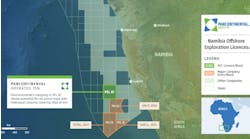Tower gains clearer picture of oil migration in offshore Namibia blocks
Offshore staff
LONDON — Tower Resources has issued a progress report on recent basin modeling studies over the PEL 96 license offshore Namibia.
This covers offshore blocks 1910A, 1911 and 1912B. Tower operates the license with an 80% interest.
A basin and thermal maturity study has improved the company’s understanding of the hydrocarbon prospectivity, with results integrated with seismic sequence stratigraphic interpretation of the large 2D seismic datasets and with well data both from the license and elsewhere in the Walvis Basin region.
Analysis shows evidence of a working petroleum system within the Dolphin Graben in PEL 96, in the form of oil recovered from cores in the 1911/15-1 well and direct hydrocarbon indicators (DHIs) observed on seismic.
Main aims of the study were to investigate key elements of the hydrocarbon charging system, such as thermal maturity, distribution of generative source kitchens, volumetric estimation of generative capacity of mature source rocks, timing of generation/expulsion of hydrocarbons, and mapping of migration pathways.
Lower Cretaceous syn-rift sediments within the main depocenters of the Dolphin Graben appear to be mature for main oil and late oil generation, which probably started in the mid-Tertiary (Oligocene) phase and has since continued to the present.
As for mapped migration pathways for oil charge, the main fetch areas capable of directing migration toward each of the main prospects could potentially have generated oil within the following ranges: Alpha Prospect fetch area - 45-79 Bbl of oil, Gamma Prospect fetch area 15-23 Bbl.
There is also potential for stratigraphic traps directly on several of the main migration pathways out of the generative kitchens, with analogies to the recent large oil discoveries in the Orange Basin off South Africa and Namibia.
Tower is now conducting an accompanying oil seep analysis and a review of existing volumetric data on already identified prospects and leads.
Tower Chairman and CEO Jeremy Asher said the findings explain the results of a previous well drilled by Norsk Hydro in the area, the source of the lacustrine oil found and the reasons why that oil found its way into that well and subsequently migrated away from it.
06.16.2023





